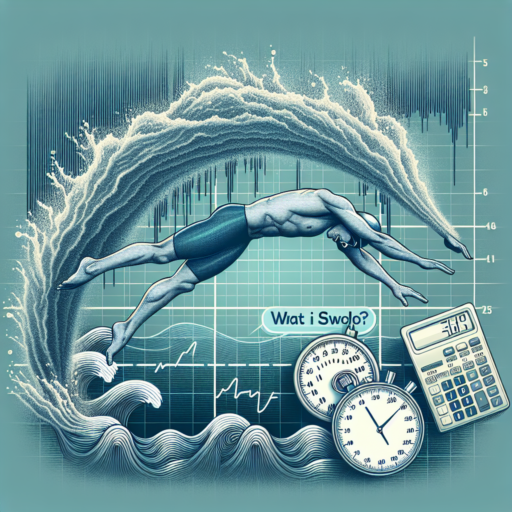Introduction to SWOLF: Understanding Its Definition and Importance
SWOLF, a term combining ‘swim’ and ‘golf’, emerges as a key metric in the realm of competitive swimming and personal fitness tracking. At its core, SWOLF aims to measure a swimmer’s efficiency by combining the number of strokes taken with the elapsed time for a given distance. This unique metric offers both coaches and athletes a quantitative insight into swimming performance, providing a clear and concise way to gauge efficiency in the water.
Understanding SWOLF’s importance requires an appreciation for its role in optimizing swimming techniques. By focusing on lowering one’s SWOLF score—achieving the distance with fewer strokes and within a shorter time—swimmers can hone their technique to become more efficient. This approach not only improves speed but also enhances overall endurance, making it an invaluable tool for swimmers at all levels of their training regimen.
Moreover, SWOLF transcends the boundaries of competitive swimming, finding its relevance in the world of fitness swimming. As fitness enthusiasts seek measurable ways to track their progress and efficiency in the water, SWOLF presents itself as a versatile metric. Notably, the simplicity of the SWOLF score makes it accessible to a wide audience, from professional athletes to casual swimmers looking to monitor their improvement over time.
How to Calculate Your SWOLF Score: A Step-By-Step Guide
Calculating your SWOLF score, a measure widely used in swimming to evaluate efficiency, might initially seem intricate. However, breaking it down into manageable steps simplifies the process. This score combines the time (in seconds) it takes to swim a pool length with the number of strokes needed to cover that distance. The lower your SWOLF score, the more efficient you are in the water.
Step 1: Time Your Swim
Start by timing yourself. Use a stopwatch or a smartwatch capable of recording laps to accurately measure the time it takes to swim one length of the pool. For consistency, ensure that you start timing from a complete stop and cease the moment you touch the wall at the other end. Record this time in seconds.
Step 2: Count Your Strokes
Immediately after completing the timed swim, recall and jot down the number of strokes you took. A stroke is counted every time one of your arms completes a full cycle, meaning both arms account for two strokes. It’s crucial to maintain your regular swimming pace and style for an accurate count.
Step 3: Calculate Your SWOLF Score
The final step is straightforward. Add the time (in seconds) it took to swim the pool length to the number of strokes you used. For example, if it took you 30 seconds to swim one length and you counted 20 strokes, your SWOLF score would be 50. This combined figure reflects your swimming efficiency, with lower scores indicating better performance and efficiency.
Why SWOLF Matters: Benefits of Tracking Your Swimming Efficiency
The concept of SWOLF, a composite score combining strokes and the time taken to swim a pool length, has increasingly become a fundamental aspect for swimmers seeking to enhance their performance. By focusing on SWOLF, swimmers can unlock a comprehensive overview of their swimming efficiency, making it a crucial metric for anyone serious about their swimming journey. We delve into the myriad benefits this tracking offers, highlighting why it’s not just for competitive swimmers but essential for anyone looking to improve their aquatic prowess.
Enhancing Stroke Efficiency
One of the core benefits of monitoring SWOLF scores is the improved stroke efficiency it promotes. This metric encourages swimmers to minimize the number of strokes while also speeding up their pace, leading to a more energy-efficient swimming technique. Through regular tracking, swimmers can pinpoint areas of improvement, from stroke length to timing, making each swim session a step towards a higher swimming efficiency level.
Personalized Performance Feedback
SWOLF isn’t just a number; it’s a personal benchmark that provides individualized feedback on performance. By comparing SWOLF scores over time, swimmers can gauge their progress with precision, offering a clear picture of how technique adjustments and training intensities affect their efficiency in the water. This level of insight is invaluable for setting realistic goals and designing training sessions that directly target efficiency improvements.
Ultimately, the benefits of tracking your SWOLF score extend beyond the pool. It empowers swimmers with the knowledge and metrics needed to make every stroke count, paving the way towards achieving not just speed but also a sustainable and efficient swimming technique. Embracing SWOLF tracking is a step forward in refining your skills, enhancing your performance, and enjoying the journey of swimming with a focus on continuous improvement.
Improving Your SWOLF Score: Practical Tips and Techniques
Understanding and improving your SWOLF score is essential for swimmers seeking to enhance their efficiency and speed in the water. This measurement combines the number of strokes you take per length with the time it takes to swim that length, offering a comprehensive insight into your swimming proficiency. To achieve a lower SWOLF score, which signifies greater efficiency, incorporating specific tips and techniques into your training regime is key.
Focus on Technique
Perfecting your swimming technique plays a pivotal role in reducing your SWOLF score. Concentrate on streamlining your body position to minimize resistance and improve your stroke efficiency. This includes executing a proper arm pull, maintaining a stable head position, and developing a strong kick. Regularly practicing drills that emphasize these elements can lead to significant improvements in your overall performance and SWOLF score.
Incorporate Interval Training
Another effective strategy for SWOLF score improvement is to include interval training in your workouts. Interval training combines periods of high-intensity swimming with rest or low-intensity periods, allowing you to focus on maintaining a low stroke count while swimming at a faster pace. This type of training not only enhances your aerobic capacity but also teaches your body to swim more efficiently under fatigue, which is crucial for lowering your SWOLF score.
Remember, while focusing on lowering your SWOLF score, it’s important to maintain a balanced approach in your training. Paying attention to technique, incorporating varied training methods, and analyzing your performance data can collectively lead to notable improvements. With consistent effort and the right strategies, you can enhance your swimming efficiency and see a positive change in your SWOLF score.
Comparing SWOLF Scores: What is a Good SWOLF Number?
Understanding and comparing SWOLF scores is crucial for swimmers seeking to enhance their efficiency in the water. SWOLF, a term combining ‘swim’ and ‘golf’, measures a swimmer’s efficiency by adding together the time taken to swim a specific distance and the number of strokes required. But what constitutes a good SWOLF number? The answer isn’t straightforward, as it significantly varies among individuals and is influenced by factors like swimming style, physical capabilities, and the distance being measured.
A good SWOLF score is often lower than one’s average, indicating improved efficiency. Generally, for athletes swimming a 25-yard pool, a SWOLF score in the range of 30 to 40 is considered excellent, but this can vary based on the context mentioned above. For beginners or those new to tracking their SWOLF scores, observing trends in their scores over time can be more beneficial than comparing with others. As swimmers become more proficient, they typically see a decrease in their SWOLF score, signifying greater efficiency in the water.
It’s vital to utilize SWOLF scores as a personal benchmark rather than a competitive comparison tool. By focusing on individual improvement and consistency, swimmers can effectively use SWOLF to identify areas of strength and opportunities for growth. Whether you’re a professional aiming for peak performance or a hobbyist looking to streamline your strokes, understanding your SWOLF score in the context of your own progress is essential. Encouraging swimmers to compete against their previous scores, rather than an arbitrary standard, fosters a healthier and more productive approach to enhancing swimming efficiency.
SWOLF and Swimming Gadgets: How Technology Can Help You Track Your Score
Understanding your swimming efficiency is key to improving your performance, and that’s where SWOLF scores come into play. SWOLF, a term that combines «Swim» and «Golf,» measures how efficient you are in the water by adding together your strokes per length with the time it takes to complete a pool length. Lower scores indicate higher efficiency, akin to golf scores. With the advent of modern swimming gadgets, tracking your SWOLF score has never been easier, allowing swimmers of all levels to gain precise insights into their swimming technique and performance.
Swimming gadgets, ranging from waterproof smartwatches to specialized swim trackers, now come equipped with the functionality to automatically calculate your SWOLF score. These devices not only track your strokes and time but also provide a detailed analysis of your swimming pattern, offering suggestions for improvement. Whether you’re a professional athlete or a swimming enthusiast, incorporating technology into your swim practice can lead to substantial improvements in not just your SWOLF score, but your overall swimming performance as well.
Given the variety of devices available, it’s important to select one that best fits your needs. Some devices offer advanced features beyond just SWOLF tracking, such as heart rate monitoring, GPS tracking for open water swims, and even coaching tips. These features can significantly enhance your training regimen by providing a comprehensive overview of your swim sessions. By leveraging the power of these swimming gadgets, you can set realistic goals, track your progress, and ultimately become a more efficient swimmer.
Expert Insights: How Professionals Use SWOLF to Enhance Performance
Exploring the utility of SWOLF within the professional realm unveils a treasure trove of strategies aimed at boosting performance. SWOLF, an efficacy indicator combining swimming and golf concepts, acts as a pivotal metric for athletes striving to refine their efficiency in the water. Professionals leverage this unique scoring system to dissect and subsequently enhance their stroke technique and overall speed.
The crux of employing SWOLF lies in its simplicity and the profound insights it delivers. By focusing on the sum of strokes and the time taken to cover a predetermined distance, athletes and coaches can pinpoint areas requiring optimization. Speed and efficiency, the heart and soul of competitive swimming, thus become quantifiable targets for improvement. It is this quantification that enables professionals to craft targeted training programs, elevating their performance to new heights.
Moreover, the integration of SWOLF scores into regular training sessions fosters a culture of continuous improvement. Athletes begin to view their performances through a more analytical lens, understanding that a lower SWOLF score indicates heightened efficiency in the pool. This realization empowers them to experiment with different techniques, breathing patterns, and stroke types, all in the quest to find the perfect balance that augments their SWOLF score and, subsequently, their race times.
No se han encontrado productos.
SWOLF in Training: Incorporating SWOLF into Your Swimming Workouts
Utilizing SWOLF in your swimming training can drastically change the way you approach your workouts. This metric, combining the number of strokes with the time it takes to swim a given distance, offers a comprehensive overview of your swimming efficiency. Emphasizing SWOLF in your training regimen isn’t just about pushing for lower times; it’s about refining your technique to become as efficient as possible in the water.
When you start to incorporate SWOLF into your swimming workouts, the focus shifts towards optimizing every aspect of your swim—from the power of your push-off to the precision of your strokes. It’s not merely about increasing your speed or endurance; it’s about achieving efficiency that translates to better performance across all swimming disciplines. By regularly tracking your SWOLF score, you can identify areas of improvement and adjust your training methods to target these weaknesses.
To effectively integrate SWOLF into your routine, consider including drills that emphasize stroke lengthening, refining your turns, and enhancing your overall coordination in the water. These components are crucial for reducing your stroke count and improving your time, thereby lowering your SWOLF score. Examples of such drills could include single-arm strokes, catch-up drills, and flip turn practices, each focusing on different aspects of your swimming technique that directly contribute to your SWOLF efficiency.
Beyond the technical improvements, incorporating SWOLF scores into your workouts encourages a more mindful swimming practice. It urges swimmers to pay close attention to their body movements, breathing patterns, and stroke efficiency, fostering a more connected and introspective approach to training. As you become more aware of these elements, adjusting your technique for better SWOLF scores can also lead to a more enjoyable and rewarding swimming experience.
FAQs on SWOLF: Answering Your Most Common Questions
Understanding SWOLF is crucial for swimmers aiming to enhance their efficiency in the water. This blend of «swim» and «golf» scores your strokes plus the time taken to swim a pool length, offering insights into your swimming proficiency. With numerous athletes and coaches frequently inquiring about its importance and optimization, we’ve curated a list of the most common questions to shed some light on this essential metric.
What Exactly is SWOLF and How is it Calculated?
At its core, SWOLF is a numerical expression that combines your stroke count with the time it takes to complete a lap. Specifically, if you take 30 strokes to swim a pool length and it takes you 45 seconds, your SWOLF score would be 75. The goal is to lower this score over time, symbolizing improved efficiency and skill in the water. It’s a simple yet powerful tool used by swimmers of all levels to monitor and enhance their performance.
Why is Monitoring My SWOLF Score Important?
Keeping an eye on your SWOLF score offers several benefits. Primarily, it prompts you to focus on both speed and stroke efficiency – two critical components of successful swimming. A lower SWOLF score indicates that you’re able to cover distances faster with fewer strokes, reducing energy expenditure, and potentially improving overall race times. Whether you’re a competitive swimmer or a recreational one, understanding and improving your SWOLF score can significantly impact your swimming prowess.
Conclusion: Taking Your Swimming to the Next Level with SWOLF
Improving your swimming efficiency and performance doesn’t have to be a guessing game. With SWOLF, a combination of ‘swim’ and ‘golf’, where lower scores indicate better efficiency, swimmers of all levels can gain precise insights into their swimming technique and progress. By focusing on reducing your SWOLF score, you’re essentially honing the two key elements of successful swimming: speed and efficiency.
One of the most beneficial aspects of utilizing SWOLF scores is the ability to set tangible, measurable goals. By tracking your scores over time, you can see direct correlations between changes in your technique, your training intensity, and your performance outcomes. Whether you’re a competitive swimmer looking to shave seconds off your personal best, or a recreational swimmer seeking to enhance your fitness level, SWOLF scoring provides a clear path to improvement.
Furthermore, incorporating SWOLF scores into your training regime encourages a more mindful approach to swimming. Instead of focusing solely on the number of laps completed or the distance swum, SWOLF invites you to consider how effectively you’re moving through the water. This shift in focus can lead to significant improvements in your stroke technique, breathing patterns, and overall swimming efficiency, ultimately taking your swimming to the next level.




